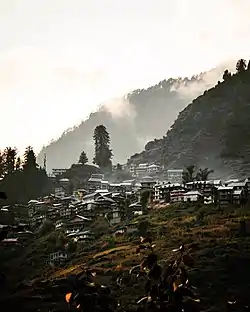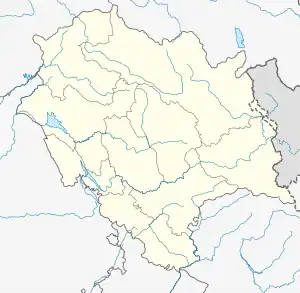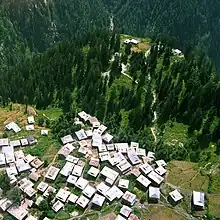Malana | |
|---|---|
Village | |
 | |
 Malana Location in Himachal Pradesh, India  Malana Malana (India) | |
| Coordinates: 32°03′46″N 77°15′38″E / 32.06278°N 77.26056°E | |
| Country | |
| State | Himachal Pradesh |
| Population (July 2017[1]) | |
| • Total | 4,700 |
| Languages | |
| • Official | Hindi |
| Time zone | UTC+5:30 (IST) |
Malana is an ancient Indian village in the state of Himachal Pradesh. The only village in the Malana Nala, a side valley of the Parvati Valley northeast of the Kullu Valley, it is isolated from the rest of the world. The peaks of Chanderkhani and Deo Tibba shadow the village. It is situated on a remote plateau by the torrential Malana river, at a height of 2,652 metres (8,701 ft) above sea level. Malana has its own lifestyle and social structure, and people are strict in following their customs. Malana has been the subject of various documentaries, including Malana: Globalization of a Himalayan Village.[2] and Malana, A Lost Identity.[3] The existing speakers of the autochthonous language Kanashi, the traditional language of the inhabitants of Malana, number approximately 1700. According to the 1961 census, the language speakers were then 563, but today the population of Malana is at least three times as large as 40 years ago.[4] The most common route to the village is by taxi or bus from Jhari. Roads to Malana Village trekking gate are developed.
History
According to local legends, Jamlu rishi (sage) inhabited this place and made rules and regulations. The locals claim it was one of the oldest democracies of the world, with a well-organized parliamentary system, guided by their devta (deity) Jamlu rishi.[5] Although Jamlu is currently identified with a sage from the Puranas, this is a relatively recent development. Jamlu is believed to have been worshipped in pre-Aryan times. Penelope Chetwood recounts a tale about an orthodox Brahmin priest, who visited Malana, and tried to educate the locals about the pedigree of their god, and what subsequently befell the hapless priest.[6]
Malana has been called ‘one of the oldest democracies’ in the world.[7][8] The villagers believe that they are descendants of the soldiers of Alexander the Great who got stranded here on account of injuries. [9][10]
A dam project, the Malana Hydro Power Station, has brought Malana much closer to the rest of the world and provides revenue for the region. A new road has shortened the walking time from several days to just 4 hours. The Hydro Malana Project has also ruined the beauty of the valley. On 5 January 2008, a raging fire in the village, which burnt for more than 5 hours, destroyed cultural structures and parts of ancient temples located in the village.[11] In 2017, the village ordered the closure of approximately a dozen guest houses and restaurants, ostensibly on the orders of the deity Jamlu.[1]
Government
Although the village is situated in Himachal Pradesh, India, people of this village do not consider them to be a part of India. They have their own judiciary system as well. The village is governed by a bicameral parliament, consisting of lower house called the Kanishthang and an upper house called the Jayeshthang.[1] The current panchayat is Bhagi Ram.[1]
Language
The residents of Malana speak Kanashi/Raksh (supposedly the dialect of people residing there long ago),[12] which is understood only by the villagers. "Kanashi, the language of Malana, does not resemble any of the dialects spoken in its neighbourhood but seems to be a mixture of Sanskrit and several Tibetan dialects."[13] Ethnologue classifies Malana as a Tibetan-Burmese language, rather than as a member of the Indo-European languages,[14] and notes that Kanashi has no intelligibility with any Tibeto-Burman language of Kinnaur"[14] although Malana is surrounded by Indo-Aryan language speaking populations.
Economy
The economy of Malana was traditionally based on making baskets, ropes and slippers from hemp.[1] Marijuana was cultivated as a legal cash crop for centuries.[15] Beginning in the 1980s, Malana became a destination for recreational drug tourism.[1] The village also produces maize and potatoes.[1] While tourism is now a major source of income for the village, tourists can only stay outside of the village in cafes like The Marley Shed, Baba Cafe, Cafe Rudra, and more, but not inside the village or in homesteads which was previously allowed.
Culture and lifestyle

The village administration is democratic and is believed, by locals, to be the oldest republic of the world.[16]
Despite being a part of the Kullu valley, there is a myth that the Malanis have very distinct physical features, and a dialect which is different from the rest of the valley. However, in the valleys of Himachal, there are a significant number of distinct Pahadi dialects, some of them totally different from each other. Hence the physical/lingual uniqueness cannot be proven, given the inaccessibility of the Malana people, except for the trade of Marijuana / Hashish in the Parvati valley.
Jamblu Devta
The social structure of Malana in fact rests on villagers' unshaken faith in their powerful deity, Jamblu Devta. The entire administration of the village is controlled by him through a village council. This council has eleven members and they are believed to be delegates of Jamblu who govern the village in his name. His decision is ultimate in any dispute and any outsider authority is never required. Thus Malana has been named the Athens of the Himalayas.[17]
Jamlu is invoked through a villager serving as an oracle.[1] The deity Jamalu is known as Rishi Jamdagni.
Hellenic connection
There are various legends about their origin. According to one of them, it is believed that they are the descendants of Greek soldiers of Alexander's army. As the legend goes, some soldiers took refuge in this remote land after Alexander left the country and later settled there permanently. This myth is however disputed because there are those who claim that it is the valley of Kalash, in Pakistan that is actually the area in which Alexander the Great's soldiers took refuge. This legend is also inconsistent with the legendary descent of the local people from Indo-Aryans who would pre-date Alexander the Great's soldiers by approximately a thousand years. Recent genetic typing of the Malani population is much more consistent with an Indo-Aryan origin with a large proportion of Y-DNA haplotypes J2 and R1a which are the haplotypes of majority of Indians, North or South in South Asia rather than with a Greek origin which would have a different characteristic mix of Y-DNA haplotypes such as R2b.[16] J2 and R1a are paternal lineages found in more than 20% and 40% of population of North/South India but are rare in Mediterranean societies like Greece.
Temples
The village has several ancient temples. (1) Jamlu temple, built in Kathkuni style, with wooden carving and deer heads[11] (2) Rukmini temple
Malana Cream
Malana is famous for its “Malana Cream”, a product made from cannabis plants which grow in the Parvati valley.[18][1] Malana cream is regarded as high purity hash.[19] In order to make Malana Cream the live cannabis flower is rubbed between the hands repeatedly, pulling out the resin to generate a layer of sticky hashish across the palm.[20]
References
- 1 2 3 4 5 6 7 8 9 Bisht, Gaurav (11 July 2017). "'Deity orders' closure of joints, guest houses at Malana village famous for hash". Hindustan Times. Archived from the original on 14 July 2017.
- ↑ Malana: Globalization of a Himalayan Village, 2010 Archived 28 June 2010 at the Wayback Machine
- ↑
- ↑ Malana : Shangrila in the Himalayas
- ↑ Kulu The End of the Habitable World By Penelope Chetwode page 89 ISBN 81-85113-20-3
- ↑ Kulu The End of the Habitable World By Penelope Chetwode page 90 ISBN 81-85113-20-3
- ↑ "Malana - World's Oldest Democracy - Kullu". kullutourism.com. Retrieved 9 January 2018.
- ↑ "यहां सदियों से गांव की संसद ही तय करती है कायदा कानून - Amarujala". Amar Ujala. Retrieved 9 January 2018.
- ↑ "Residents of this Himachal village claim to be the descendants of Alexander The Great". dailybhaskar. 13 December 2014. Retrieved 9 January 2018.
- ↑ "Experts to study Alexander's 'last descendants' in Himachal - Times of India". The Times of India. Retrieved 9 January 2018.
- 1 2 Joshi, Namratha (26 January 2008). "Jamlu's fire". Outlook magazine. M/s Kasturi ad sons. Retrieved 12 July 2015.
- ↑ "About Malana" "About Malana". Archived from the original on 20 March 2011. Retrieved 26 July 2010.
- ↑ Dr. Virendra Bangroo, "Malana: A Lost Utopia In The Himalayas," http://ignca.nic.in/nl002401.htm
- 1 2 Kanashi at Ethnologue (25th ed., 2022)

- ↑ Dutta, Prabhash K. (4 December 2016). "For this Himachal village, banned cannabis is its source of livelihood". India Today.
Local lawmakers and officials say the plant is part of their tradition and empathize with people in steep, remote villages who consider cannabis the only cash crop they can grow in harsh weather and geographic conditions. Maheshwar Singh, a local lawmaker and the descendant head of the royal family of Kullu, said a look at the old tax books shows that the plant was legally cultivated and sold for decades before India's drug law.
- 1 2 Giroti, R; Talwar, I (April 2010). "The Most Ancient Democracy in the World is a Genetic Isolate: An Autosomal and Y-Chromosome Study of the Hermit Village of Malana (Himachal Pradesh, India)". Hum. Biol. 82 (2): 123–41. doi:10.3378/027.082.0201. JSTOR 41466666. PMID 20649396. S2CID 22324205.
- ↑ Malana (Manali): Athènes de l'Himalaya
- ↑ Chhabra, Aarish (21 March 2017). "Hash through hashtag: Himachal's famed marijuana on sale via Instagram, Speed Post". Hindustan Times.
Other photos had an entry gate of Malana, considered to have the best quality of cannabis in the world.
- ↑ Balachandran, Manu (11 July 2017). "An ancient Himalayan village known for India's best hash is now off limits for tourists". Quartz.
An isolated village nestled in the Himalayas, Malana is popular for Malana Cream, a strain of cannabis with a high oil content and intense aroma [...] Malana Cream is among the most expensive hashish on the famed cannabis menus of Amsterdam. A tola, or 11.66 grams, sells for over $250 there and over Rs4,000 ($60) in India.
- ↑ "Among the world's top stoner spots, Malana now cannot do without marijuana". 4 December 2016.
Further reading
- Chakraborty, Mehk. "Malana: A Himalayan village shrouded in myth". bbc.com.